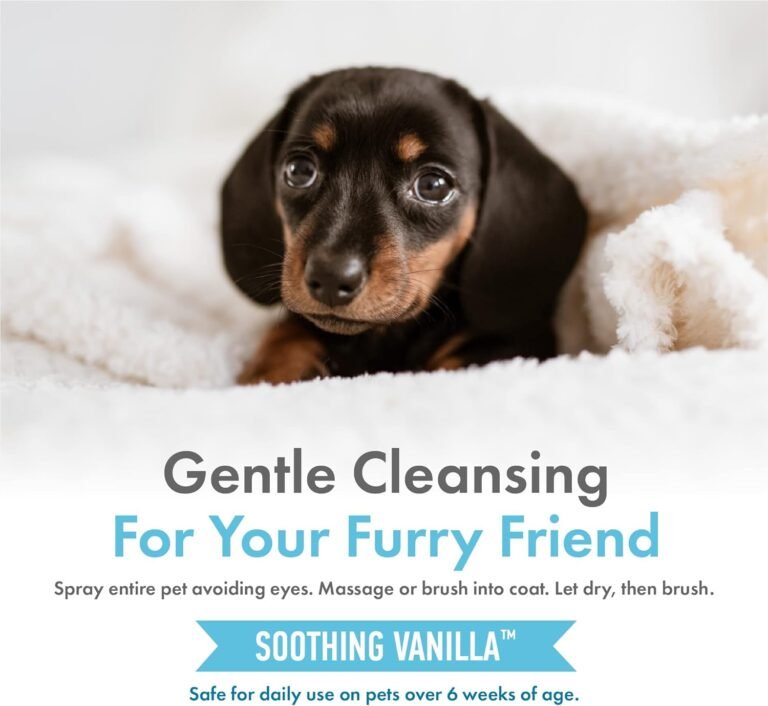Effective Grooming Techniques for a Healthy Pet : Practical grooming tips and tricks that contribute to overall pet health, focusing on skin and coat care.
Proper grooming is essential for maintaining the overall health and well-being of your pet. Regular grooming not only keeps your pet looking and smelling great, but it also plays a crucial role in promoting healthy skin and coat. By following effective grooming techniques, you can ensure that your pet’s skin remains free from irritations and infections, and their coat stays shiny and tangle-free. In this article, we will explore practical grooming tips and tricks that contribute to overall pet health, with a specific focus on skin and coat care.
Key Takeaways
- Regular grooming is crucial for maintaining your pet’s overall health and well-being.
- Grooming helps to promote healthy skin and coat by preventing irritations and infections.
- Choosing the right brushes and combs is essential for effective grooming.
- Proper bathing and drying techniques can help prevent skin irritation.
- Regular ear cleaning and nail trimming are important for maintaining your pet’s hygiene.
Understanding the Importance of Grooming for Pet Health

The Benefits of Regular Grooming
Regular grooming is essential for maintaining the health and wellbeing of your pet. It not only keeps their coat looking shiny and beautiful, but it also plays a crucial role in their overall skin health. Grooming helps to remove dirt, debris, and dead hair from your pet’s coat, preventing matting and tangling. By regularly brushing your pet’s fur, you can also stimulate the production of natural oils, which helps to keep their skin moisturized and prevents dryness and itchiness. Additionally, grooming allows you to closely inspect your pet’s skin for any signs of irritation, parasites, or other skin conditions, ensuring early detection and prompt treatment if necessary. By taking the time to groom your pet regularly, you are not only keeping them looking their best, but you are also contributing to their overall whisker wellbeing.
How Grooming Contributes to Skin and Coat Health
Proper grooming practices play a crucial role in maintaining the overall health of your pet’s skin and coat. Regular brushing helps to distribute natural oils, keeping the coat healthy and shiny. It also helps to remove dirt, debris, and loose hair, preventing matting and tangling. Dog shampoo is another important tool in maintaining skin and coat health. Using a high-quality dog shampoo that is specifically formulated for your pet’s skin type can help to keep the skin clean and free from irritants. It is important to choose a shampoo that is gentle and does not strip the natural oils from the skin. Regular bathing with the appropriate shampoo can help to prevent skin issues such as dryness, itching, and allergies. Additionally, it is important to follow proper bathing and drying techniques to avoid skin irritation. Remember to always rinse thoroughly to remove all traces of shampoo and use a towel or a hairdryer on a low heat setting to dry your pet’s coat completely.
Essential Tools for Effective Pet Grooming

Choosing the Right Brushes and Combs
When it comes to grooming your pet, choosing the right brushes and combs is essential. Different types of brushes and combs are designed for specific coat types and textures, so it’s important to select the ones that are most suitable for your pet. For example, if your pet has a long, thick coat, a slicker brush with fine, short bristles can help remove tangles and mats. On the other hand, if your pet has a short coat, a bristle brush with firm, natural bristles can effectively remove loose hair and distribute natural oils. Regular brushing not only keeps your pet’s coat looking great, but it also helps to stimulate blood circulation and promote a healthy skin and coat. By using the right brushes and combs, you can ensure that your pet’s grooming routine is effective and enjoyable for both of you.
Must-Have Grooming Supplies for Skin and Coat Care
When it comes to grooming your pet’s skin and coat, having the right supplies is essential. Here are some must-have grooming supplies that will help you keep your pet’s skin and coat healthy:
-
Brushes and Combs: Choose brushes and combs that are specifically designed for your pet’s coat type. This will ensure that you can effectively remove tangles and mats without causing any discomfort to your pet.
-
Shampoo: Select a shampoo that is formulated for your pet’s skin type. Whether your pet has dry skin, sensitive skin, or any other skin condition, using the right shampoo will help maintain a healthy coat.
-
Conditioner: Using a conditioner after shampooing can help moisturize your pet’s skin and coat, leaving it soft and shiny.
-
Nail Clippers: Trimming your pet’s nails regularly is important for their overall health. Invest in a good pair of nail clippers that are safe and easy to use.
-
Ear Cleaner: Keeping your pet’s ears clean is crucial to prevent infections. Look for an ear cleaner that is gentle and effective in removing dirt and debris.
Remember, having these essential grooming supplies will make the grooming process easier and more enjoyable for both you and your pet.
Proper Techniques for Brushing and Detangling

Step-by-Step Guide to Brushing Your Pet’s Coat
Brushing your pet’s coat is an essential part of their grooming routine. It helps to remove loose hair, prevent matting, and distribute natural oils for a healthy and shiny coat. To effectively brush your pet’s coat, follow these steps:
-
Start by using a slicker brush to remove any tangles or mats. Gently brush in the direction of hair growth, using short strokes. Be careful not to pull or tug on the hair, as this can cause discomfort.
-
Once the tangles are removed, switch to a bristle brush or comb to further groom the coat. These tools help to remove loose hair and distribute natural oils. Brush in the direction of hair growth, using long, sweeping strokes.
-
Pay special attention to areas that are prone to matting, such as behind the ears, under the armpits, and around the tail. Use your fingers or a detangling spray to gently work through any knots or tangles.
-
If your pet has a long or thick coat, consider using a de-shedding tool to remove excess hair. This can help to reduce shedding and keep your pet’s coat looking its best.
Remember to be gentle and patient when brushing your pet’s coat. Take breaks if needed, and reward your pet with treats and praise for good behavior. Regular brushing not only keeps your pet looking great, but it also promotes a healthy coat and skin.
Tips for Detangling Matted Fur Safely
Detangling matted fur can be a challenging task, but with the right techniques and tools, you can make it a hassle-free maintenance routine. Here are some tips to help you safely detangle your pet’s fur:
-
Start by using a wide-toothed comb or a dematting tool to gently loosen the knots and tangles. Be patient and avoid pulling or tugging on the fur, as this can cause discomfort or pain for your pet.
-
If the mat is too stubborn to comb through, you can try using a detangling spray or conditioner. Apply a small amount to the mat and gently work it through with your fingers or a comb.
-
For larger mats that cannot be easily detangled, it may be necessary to trim them out. Use a pair of blunt-tipped scissors and carefully cut the mat away from the surrounding fur. Take caution not to cut your pet’s skin.
-
After detangling or trimming the mats, brush your pet’s fur thoroughly to remove any loose hairs and prevent future tangles. Regular brushing is key to maintaining a healthy coat.
Remember, detangling matted fur requires patience and gentle handling. If you’re unsure or uncomfortable doing it yourself, it’s best to seek professional help from a groomer or veterinarian.
Bathing and Drying Methods for Healthy Skin

Choosing the Right Shampoo for Your Pet’s Skin Type
When it comes to choosing the right shampoo for your pet’s skin type, it’s important to consider their specific needs. Different pets have varying skin types, ranging from normal to sensitive. Using the wrong shampoo can lead to skin irritation and other issues. Here are some tips to help you make the right choice:
- Identify your pet’s skin type: Is it dry, oily, or normal?
- Consult with your veterinarian: They can provide recommendations based on your pet’s specific needs.
- Read the labels: Look for shampoos that are formulated for your pet’s skin type.
Remember, using an inappropriate shampoo can cause dryness or excessive oiliness. It’s important to find a shampoo that balances your pet’s skin and keeps it healthy and clean. By choosing the right shampoo, you can ensure that your pet’s skin remains in optimal condition.
Proper Bathing and Drying Techniques to Prevent Skin Irritation
When it comes to bathing and drying your pet, it’s important to follow proper techniques to prevent skin irritation. Whisker Wellbeing is a crucial aspect of your pet’s overall comfort and health, and it’s important to take extra care when washing their face. Use a gentle, pet-friendly shampoo that is specifically formulated for their skin type. Avoid getting shampoo in their eyes, nose, or mouth, as this can cause discomfort and irritation. After rinsing off the shampoo, make sure to thoroughly dry your pet’s face, including their whiskers, to prevent any moisture from lingering and causing skin issues.
Maintaining Healthy Ears and Nails

How to Safely Clean Your Pet’s Ears
Cleaning your pet’s ears is an important part of their grooming routine. It helps prevent ear infections and keeps their ears healthy. Here is a step-by-step guide to safely clean your pet’s ears:
- Start by gathering the necessary supplies, including ear cleaning solution and cotton balls.
- Gently hold your pet’s ear flap and lift it slightly to straighten the ear canal.
- Apply a few drops of the ear cleaning solution into the ear canal.
- Massage the base of the ear for about 30 seconds to help loosen any debris.
- Use a cotton ball to gently wipe away the dirt and excess solution.
- Repeat the process for the other ear.
Remember to be gentle and patient while cleaning your pet’s ears. If you notice any redness, swelling, or discharge, consult your veterinarian for further evaluation and treatment.
Trimming Your Pet’s Nails: Best Practices and Safety Tips
When it comes to trimming your pet’s nails, there are a few best practices and safety tips to keep in mind. First and foremost, it’s important to use the right tools for the job. Sharp, high-quality nail clippers specifically designed for pets are recommended to ensure a clean and precise cut. Additionally, it’s crucial to have styptic powder on hand in case of any accidental bleeding. This powder helps to stop bleeding quickly and effectively. Regular nail trimming is essential for your pet’s comfort and overall health. Overgrown nails can cause discomfort and even lead to more serious issues such as infections or difficulty walking. By maintaining proper nail length, you can prevent these problems and keep your pet happy and healthy.
Maintaining Healthy Ears and Nails
Conclusion
In conclusion, effective grooming techniques play a crucial role in maintaining the overall health of our pets, with a specific focus on their skin and coat. By following the practical tips and tricks outlined in this article, pet owners can ensure that their furry companions have healthy and lustrous coats, free from common skin issues. Regular brushing, bathing, and proper nutrition are key factors in promoting a shiny and well-maintained coat. Additionally, it is important to pay attention to any signs of skin problems and seek veterinary advice when necessary. Remember, a well-groomed pet is a happy and healthy pet!
Frequently Asked Questions
How often should I groom my pet?
The frequency of grooming depends on the type of pet and their specific needs. Generally, dogs with longer coats may require grooming every 4-6 weeks, while shorter-haired dogs may only need grooming every 8-12 weeks. Cats usually require less frequent grooming, but it is still important to regularly brush their coat and check their ears and nails.
What are the benefits of regular grooming?
Regular grooming has several benefits for your pet. It helps to keep their skin and coat healthy by removing dirt, debris, and dead hair. Grooming also promotes good circulation and stimulates the natural oils in the skin, which can improve coat condition and shine. Additionally, grooming allows you to check for any skin issues, parasites, or abnormalities that may require veterinary attention.
How do I choose the right brushes and combs for my pet?
The type of brush or comb you need depends on your pet’s coat type. For dogs with short hair, a bristle brush or rubber curry brush is usually sufficient. Dogs with longer hair may require a slicker brush or a combination of a slicker brush and a wide-toothed comb. Cats generally benefit from a soft bristle brush or a grooming glove. It’s important to choose brushes and combs that are appropriate for your pet’s coat length and texture to avoid causing any discomfort or damage.
What grooming supplies do I need for my pet’s skin and coat care?
Some essential grooming supplies for your pet’s skin and coat care include a pet-friendly shampoo, conditioner (if necessary), a grooming brush or comb, nail clippers or a grinder, ear cleaner, and toothbrush/toothpaste for dental care. It’s also helpful to have treats on hand to reward your pet for good behavior during grooming sessions. Consult with your veterinarian or a professional groomer for specific product recommendations based on your pet’s needs.
How do I safely clean my pet’s ears?
Cleaning your pet’s ears is an important part of their grooming routine. Start by gently wiping the outer part of the ear with a damp cloth or a pet-friendly ear cleaning solution. Avoid inserting anything into the ear canal as it can cause injury. If you notice any redness, discharge, or a foul odor, it’s best to consult with your veterinarian as it may indicate an ear infection or other underlying issue.
What are the best practices for trimming my pet’s nails?
Trimming your pet’s nails is necessary to prevent overgrowth, discomfort, and potential injury. Use pet-specific nail clippers or a grinder designed for pets. Take care not to cut into the quick, which is the sensitive part of the nail that contains blood vessels and nerves. If you are unsure or uncomfortable with trimming your pet’s nails, consider seeking assistance from a professional groomer or your veterinarian.







